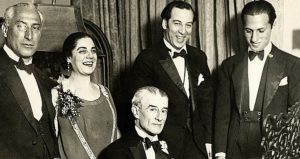Around thirty years ago, the American composer, pianist, and conductor Marvin Hamlisch said that it is not that difficult to comprehend the ‘’ingredients of Gershwin’s musical greatness”. It was, according to him, ”hot jazz, soulful blues melodies, and the Old world music”, brought to America by the Jewish immigrants. Still, Hamlisch, who is best known for the music he composed for the ”Sting”, ”Sophie’s choice and ”The way we were” hasn’t even tried to explain why and how Gershwin managed to combine them so well.
Like Hamlisch, many other musicians tried to explain the unique trace George Gershwin left in American and world history of music. The jazz double bass player Tommy Cecil thought that the ”value of Gershwin’s music doesn’t lie in the fact that it is ”multicultural.” Gershwin’s music is compelling because he employed a multitude of influences, including jazz, with brilliance, imagination, and taste.” Leonard Bernstein considered Gershwin to be the most inspired melodic on planet, since Tchaikovsky. Among numerous colleagues who admired his music are Prokofiev, Ravel, and Schoenberg.
 Gershwin (on the right) on Ravel’s birthday party
Gershwin (on the right) on Ravel’s birthday party
Let’s go back to 1924. for a moment, to the premiere of the Rhapsody in Blue. On February the 12th the concert under the name ”Experiment in modern music” was held in New York where, besides Gershwin’s composition, 25 more pieces from other authors were represented. The New York Times music critic Olin Downes wrote that the scenography was equally unconventional as the program itself. He went on describing “a scene that would have curdled the blood of a Stokowski or a Mengelberg,” two of the most revered conductors of the day, not just because the musicians drew on an instrumental arsenal that included pianos in various states of disassembly, an array of wind, brass and percussion, and “frying pans, large tin utensils, and a speaking trumpet, later stuck into the end of a trombone.”
Up to that moment, a twenty-six years old Gershwin composed his Rhapsody in just three weeks, and since he himself played the piano part, he changed and improvised some sections in the last moment. Rhapsody, which was performed at the end of a long and a bit tiring concert, provoked exhilaration and brought the audience to their feet. It seemed clear to everyone that they’ve just attended the historical turning point, both in jazz and classical music. As the musicologist, Howard Goodall would poetically notice: “by the end of those 15 minutes, the world of music had been changed forever”.
Today, Gershwin is considered as the first man to succeed in connecting jazz and classical music In such a masterly and knowingly way, and it was just the Rhapsody that secured his status as a composer of “serious music’’, grown and mature enough for big concert halls. In the period that came along the series of classical and orchestral pieces followed: Concerto in F in the next 1925, then the famous American in Paris later – the most performed piece besides Rhapsody. The popular Cuban Overture, at first named Rumba was created in 1932. as a “consequence’’ of Gershwin’s two week holiday in Havana. Last, but not least, the unavoidable Porgy and Bess – the “folk opera’’ as Gershwin liked to call it, which is still one of the most significant American operas of the 20th Century. Of course, it cannot slip our mind the huge Broadway hits that emerged from the same pen, musicals, and songs like The man I love, Summertime, I got rhythm, I’ve got a crush on you… which are known the best for the brilliant performances of Ella Fitzgerald, Frank Sinatra, Eta James, but also Barbara Streisand, Kate Bush, Norah Jones and many rock musicians (Sting, Elton John, Amy Whinehouse, John Bon Jovi…).
Gershwin, speaking about his reasoning behind Rhapsody in Blue, stated: “There had been so much chatter about the limitations of jazz, not to speak of the manifest misunderstandings of its function. Jazz, they said, had to be in strict time. It had to cling to dance rhythms. I resolved, if possible, to kill that misconception with one sturdy blow…No set plan was in my mind, no structure to which my music would conform. The Rhapsody, you see, began as a purpose, not a plan.” If by chance you find yourself near Belgrade’s Kolarac Hall on Sunday, the 22nd of April, you can hear how Gershwin’s intention interpreted by Matija Dedic – one of the most interesting jazz pianists from our region. If not, you can always decide to let that ”outrageous clarinet glissando” turn the silence of your room into the rhapsody of the luxurious sound colors, rhythms, and harmonies.
Svetlana Trtica